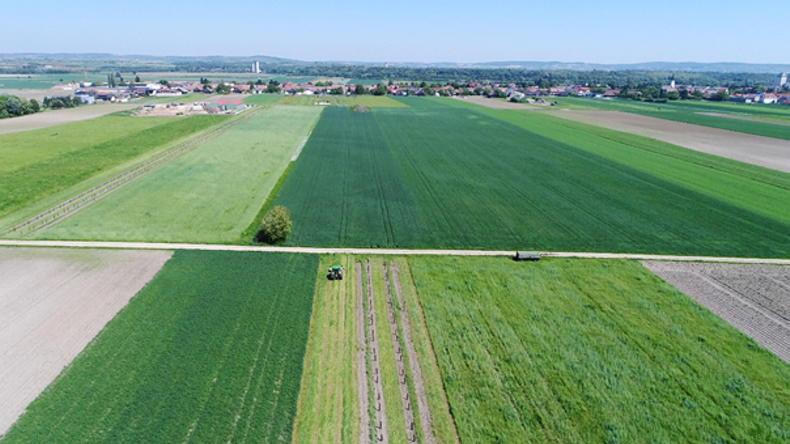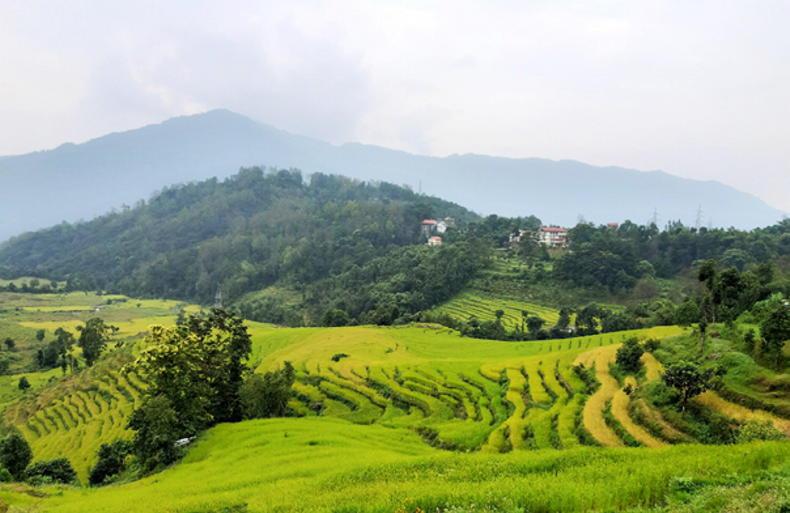It is so nice to be teaching students in person again – all 170 of them on our flagship course Exploring the Future of Farming and Food. They come from all continents and many different backgrounds. Some are the children of farmers, others are from the food industry, while others have come from backgrounds ranging from army to arts.
Many come to study crop or animal sciences; some have chosen environmental sciences, or the university’s Masters Programme in Organic Agriculture. Together, we explore where farming and food may find itself in 2030. To help them on this journey, we Zoom our Lighthouse Farmers into the classroom to treat our students to virtual excursions through the agroforestry of Brazil, or the terraced slopes of Ethiopia.
One of the most popular Zoom excursions is to our Irish Lighthouse Farm at the Lands of Dowth, where five PhD students share their research on carbon-neutral beef and lamb production. One of them is Jane Shackleton, a successful young beef farmer from Co Cavan.
Jane’s home farm is an organic farm and she is therefore well placed to answer the question: what is the role of organic farming in the future of farming and food? Throughout the course, we visited some of our Lighthouse Farms to get a glimpse of what the future of organics may hold – we found different answers everywhere we went.
Lifestyle or necessity?
Our Cuban Lighthouse Farm is located right in the heart of Havana. There, organic production is not a lifestyle choice by urban dwellers, it is a mere necessity. At the turn of the century, trade embargoes put a sudden stop to the import of agricultural inputs: farmers had to reinvent their farms overnight.

In Cuba, organic farming is not a choice of lifestyle, it is a necessity due to the lack of imported facilities.
Faced with sudden shortages of food, five of them came together to grow fresh food on the doorstep of the city. Over time, it grew to a successful co-operative of 150 employees, providing much needed jobs, cash and, above all, fresh food to numerous women and men who had lost their jobs or farms. Sounds like an urban Eden? Not quite, as this farm remains vulnerable to the woes of today’s world, as we reported on previously.
Mixed results
Fast forward to today and we see other countries experiment with a whole-territory conversion to organic farming. Last year, Sri Lanka introduced a sudden ban on all imports of fertilisers and agrochemicals, forcing its farmers to convert to organic farm practices. And this occurred just weeks before the start of the cropping season. The results were well documented in the international press – shortages and spiralling prices of food. We will never be sure if it was the ban on imports, the COVID pandemic, or the collapse of the tourist numbers that caused the crisis; in all likelihood it was all three. But the outcome was a rapid government U-turn on fertiliser imports – a tacit admission that the experiment had failed.
Meanwhile, 2000km to the north, the Indian state of Sikkim appears more successful in a similar endeavour to convert an entire territory to organic farming. Here, farmers were not suddenly left to their own devices; they were supported with knowledge campaigns. Critics have pointed at the significant drop in cereal yields. However, data from the ministry suggests that this has only been the case for barley and wheat, two crops that are not particularly well suited to the local mountainous conditions.
Figure 1 shows that the productivity of all other major crops has continued to grow throughout the conversion period. Since last year, we have teamed up with two of the local women-farmers’ self-help groups to learn more about this bottom-up approach and how they have successfully sustained organic practices for ten years.
Against the backdrop of these drastic experiments, the 25% target for organic farming in the EU may now look rather measured. Austria has already reached this target, not only on its Alpine pastures but also on the highly productive plains of the Danube river, where we find our Austrian Lighthouse Farmer Alfred Grand. But how can we explain the high demand for organic produce in Austria?

Austria has already reached the 25% target for organic farming, not only in its mountain regions, but also in the fertile lowlands of the Danube river.
Alfred explains: “People say that consumers are only interested in price. But if that were true, then there would not be a single Mercedes sold in the world. Consumers buy with their emotions and their emotions bring them to organic produce – they know and trust the organic label.”
At the end of class, Jane and I ruminate over the role of organics in the future of European farming. We agree that it is one of many approaches to sustainability, albeit the only approach that has a certification system that is internationally recognised. As such, organic farmers are already paid a premium for their stewardship of the environment. But this very same certification, with its lists of dos and don’ts, may stop other farmers from joining.
Our global network shows that organic practices cannot be forced onto an entire community. At the same time, if farmers are supported through knowledge campaigns or discussion groups, this can yield results both for farmers and for society. The farmers in the Global Network of Lighthouse Farms celebrate this diversity. Organic or not organic? That was never the question for the Lighthouse Farms. About half of them are, the other half are not. And yet together they work, together they learn, for a shared future of farming and food.
Heartland:
Follow Jane
at @shacklej
@HeartLand_S2S
Learn more about
the Sikkim
self-help group.

Sustainable farm insights lockup
It is so nice to be teaching students in person again – all 170 of them on our flagship course Exploring the Future of Farming and Food. They come from all continents and many different backgrounds. Some are the children of farmers, others are from the food industry, while others have come from backgrounds ranging from army to arts.
Many come to study crop or animal sciences; some have chosen environmental sciences, or the university’s Masters Programme in Organic Agriculture. Together, we explore where farming and food may find itself in 2030. To help them on this journey, we Zoom our Lighthouse Farmers into the classroom to treat our students to virtual excursions through the agroforestry of Brazil, or the terraced slopes of Ethiopia.
One of the most popular Zoom excursions is to our Irish Lighthouse Farm at the Lands of Dowth, where five PhD students share their research on carbon-neutral beef and lamb production. One of them is Jane Shackleton, a successful young beef farmer from Co Cavan.
Jane’s home farm is an organic farm and she is therefore well placed to answer the question: what is the role of organic farming in the future of farming and food? Throughout the course, we visited some of our Lighthouse Farms to get a glimpse of what the future of organics may hold – we found different answers everywhere we went.
Lifestyle or necessity?
Our Cuban Lighthouse Farm is located right in the heart of Havana. There, organic production is not a lifestyle choice by urban dwellers, it is a mere necessity. At the turn of the century, trade embargoes put a sudden stop to the import of agricultural inputs: farmers had to reinvent their farms overnight.

In Cuba, organic farming is not a choice of lifestyle, it is a necessity due to the lack of imported facilities.
Faced with sudden shortages of food, five of them came together to grow fresh food on the doorstep of the city. Over time, it grew to a successful co-operative of 150 employees, providing much needed jobs, cash and, above all, fresh food to numerous women and men who had lost their jobs or farms. Sounds like an urban Eden? Not quite, as this farm remains vulnerable to the woes of today’s world, as we reported on previously.
Mixed results
Fast forward to today and we see other countries experiment with a whole-territory conversion to organic farming. Last year, Sri Lanka introduced a sudden ban on all imports of fertilisers and agrochemicals, forcing its farmers to convert to organic farm practices. And this occurred just weeks before the start of the cropping season. The results were well documented in the international press – shortages and spiralling prices of food. We will never be sure if it was the ban on imports, the COVID pandemic, or the collapse of the tourist numbers that caused the crisis; in all likelihood it was all three. But the outcome was a rapid government U-turn on fertiliser imports – a tacit admission that the experiment had failed.
Meanwhile, 2000km to the north, the Indian state of Sikkim appears more successful in a similar endeavour to convert an entire territory to organic farming. Here, farmers were not suddenly left to their own devices; they were supported with knowledge campaigns. Critics have pointed at the significant drop in cereal yields. However, data from the ministry suggests that this has only been the case for barley and wheat, two crops that are not particularly well suited to the local mountainous conditions.
Figure 1 shows that the productivity of all other major crops has continued to grow throughout the conversion period. Since last year, we have teamed up with two of the local women-farmers’ self-help groups to learn more about this bottom-up approach and how they have successfully sustained organic practices for ten years.
Against the backdrop of these drastic experiments, the 25% target for organic farming in the EU may now look rather measured. Austria has already reached this target, not only on its Alpine pastures but also on the highly productive plains of the Danube river, where we find our Austrian Lighthouse Farmer Alfred Grand. But how can we explain the high demand for organic produce in Austria?

Austria has already reached the 25% target for organic farming, not only in its mountain regions, but also in the fertile lowlands of the Danube river.
Alfred explains: “People say that consumers are only interested in price. But if that were true, then there would not be a single Mercedes sold in the world. Consumers buy with their emotions and their emotions bring them to organic produce – they know and trust the organic label.”
At the end of class, Jane and I ruminate over the role of organics in the future of European farming. We agree that it is one of many approaches to sustainability, albeit the only approach that has a certification system that is internationally recognised. As such, organic farmers are already paid a premium for their stewardship of the environment. But this very same certification, with its lists of dos and don’ts, may stop other farmers from joining.
Our global network shows that organic practices cannot be forced onto an entire community. At the same time, if farmers are supported through knowledge campaigns or discussion groups, this can yield results both for farmers and for society. The farmers in the Global Network of Lighthouse Farms celebrate this diversity. Organic or not organic? That was never the question for the Lighthouse Farms. About half of them are, the other half are not. And yet together they work, together they learn, for a shared future of farming and food.
Heartland:
Follow Jane
at @shacklej
@HeartLand_S2S
Learn more about
the Sikkim
self-help group.

Sustainable farm insights lockup









 This is a subscriber-only article
This is a subscriber-only article











SHARING OPTIONS: